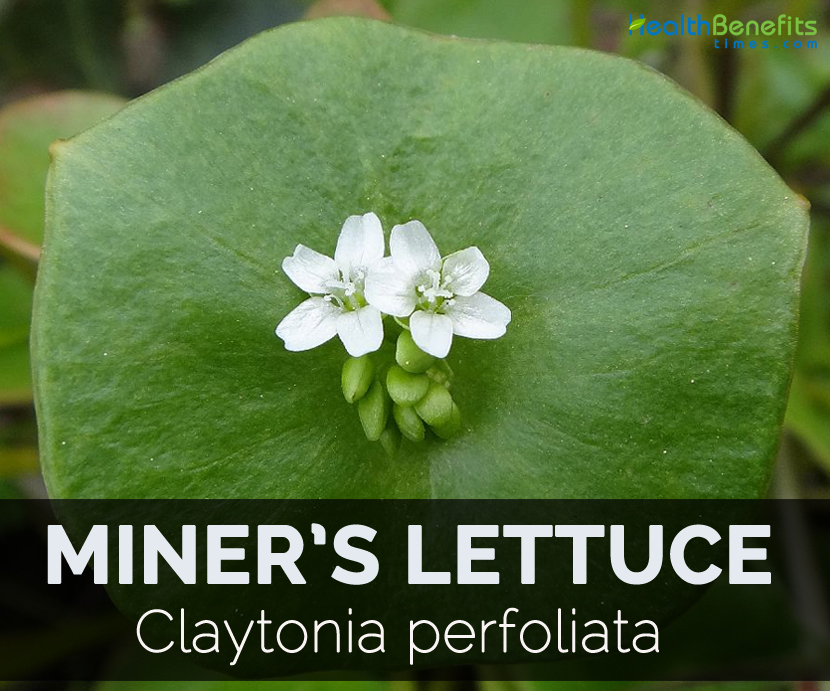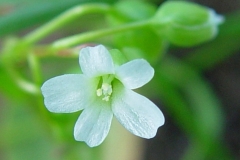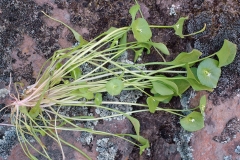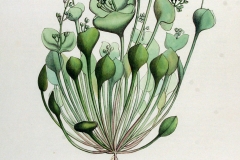Miner’s lettuce is a small, slightly succulent, herbaceous annual plant which is light green and has round and disk like leaves surrounding smooth and tender stem. As the plant blooms, there is small white and pinkish color flower that grows on top of its rounded leaves.
Flowers
Flowers are five petalled which blooms from February through May. About 5 to 40 white to pale pink flowers occur on slender down curved stalks cluster above a circular to weakly squared, cup like green structure which resembles leaf and completely surrounds the stem.
Leaves
Leaves while young are basal and are narrowly oblancolate narrowing to short petiole. Basal leaves become oval to triangular as it matures helding aloft on long petioles. Cauline leaves lack petioles and opposite on stem fusing at the base forming collar around the stem. Usually leaves are bright green.
Habitat
Generally it is found in winter and early spring in shady spots related with various types of vegetation from coastal sage scrub and chaparral to oak woodland and pine forests. Also found in wetlands but sometimes in non-wetlands. Common in western Canada and U.S. but also grows in Cuba, Central America and Australia.
Health benefits of Miner’s lettuce
- Blood purifier
Miner’s lettuce is used by the body to cleanse the body. It is a purifying green which fortifies and filter out blood and lymph systems when consumed. Chlorophyll is antioxidant rich nutrients such as Vitamin C so lettuce acts as a great detoxifier eliminating environmental toxins and heavy metals stored in liver.
- Omega fatty acids
Miner’s lettuce is closely associated to wild purslane plant. Purslane is renowned for high level of Omega-3 fatty acids is commonly found in all green leafy vegetables. Omega-3 fatty acids act as anti-inflammatory counteracting pro-inflammatory effects of LA omega-6 fats and their derived oils.
Culinary uses
- Leaves are consumed raw or cooked.
- Stalks and flowers are consumed raw. Add it to salads.
- Use it as a lettuce or spinach with paprika, dry mustard, cloves, garlic or use it in salads or garnishes for soups.
- Use it in pasta dishes, stir fries or combine it with sorrel for making pesto.
- Make it into fruity miner’s lettuce smoothie by adding pears, berries and bananas.
- Consume the leaves raw or cooked.
- Cook and serve it with meat dishes or pair with vegetables or added to pesto.
Medicinal uses
- Leaves are gently laxative.
- Use it as a tonic or effective diuretic.
- Apply the poultice made from mashed plants to rheumatic joints.
References:
https://www.itis.gov/servlet/SingleRpt/SingleRpt?search_topic=TSN&search_value=20395#null
https://www.ediblewildfood.com/miners-lettuce.aspx
Comments
| Miner's lettuce Quick Facts | |
|---|---|
| Name: | Miner's lettuce |
| Scientific Name: | Claytonia perfoliata |
| Taste | Mild |
| Name | Miner’s lettuce |
|---|---|
| Scientific Name | Claytonia perfoliata |
| Common/English Name | Indian Lettuce, Siberian Miner’s Lettuce, Candy Flower |
| Name in Other Languages | German: Claytonie, Gewöhnliches Tellerkraut; Danish: vinterportulak; Dutch: winter postelijn, winterpostelein; English: miner’s lettuce, springbeauty, miners’ lettuce, winter purslane; Finnish: perhoskleitonia, salaattikleitonia; French: claytone de cuba, claytonie de cuba, claytonia perfoliée, claytonie perfoliée, pourpier d’hiver; German: durchwachsene claytonie, claytonie, gewöhnliches tellerkraut, tellerkraut, kubaspinat, winterportulak; Italian: claitonia perfogliata, itonia perfoliata, claytonia perfogliata, porcellana d’inverno; Norwegian: vinterportulakk; Polish: szpinak kubanski, zdrojek przeszyty; Spanish: verdolaga de invierno, verdolaga de cuba; Swedish: vinterportlak |
| Soil | Well-drained |
| Plant Size | 30 cm (12″) |
| Stem | Smooth, tender |
| Leaves | Narrowly oblanceolate, light green, 2-15 centimeters in diameter |
| Flowering Season | February through May |
| Flower | White or pinkish |
| Flavor | Mild and sweet |
| Taste | Mild |





